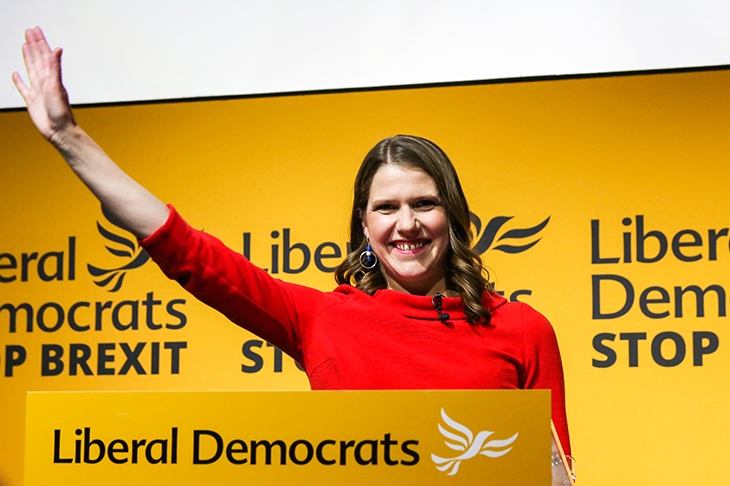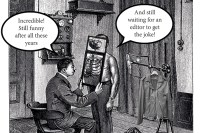When the leadership result was announced, Jeremy Corbyn’s keyboard warriors swung into action. Behold, they said: a new party leader whose track record involved overseeing years of austerity, voting for tax cuts for the super-rich and pursuing a neoliberal agenda. As for Boris the man, the Corbynites didn’t seem to mind him so much. It’s Jo Swinson, the new leader of the Liberal Democrats, who is enemy number one.
The Labour fear — and the Tory hope —is that the current Liberal Democrat resurgence continues and Labour loses seats in the North to the Tories and metropolitan seats to the Lib Dems. Under Nick Clegg, the Lib Dems were a greater threat to the Tories, but Brexit has created new opportunities. The party is now gaining support from disillusioned Labour voters who are alarmed at Corbyn’s socialism and frustrated with his ambiguous position on Brexit.
Just a year ago, the Liberal Democrats were the subject of pity and widespread mockery. They were scarred by their time in coalition with the Tories. They failed to make much ground during the 2017 snap election, ending up with just 12 MPs, and seemed destined for extinction. In theory, they should have hoovered up Remain voters. Instead, they hoovered up derision and obloquy. Sir Vince Cable announced his resignation as party leader with the future looking bleak.
However, in the topsy-turvy political landscape that is Brexit, the Lib Dems are now in the midst of a comeback that could decide who takes No. 10 at the next election. With talk of an early election, the party has an opportunity to become an influential force in British politics once again. Swinson may be unlikely to make it to No. 10 anytime soon but she could play a crucial role deciding its next incumbent. Liberal Democrat success could be the Tories’ best hope of winning an election.
The party’s big change in the past 12 months was its adoption of the slogan ‘bollocks to Brexit’, hardening its claim to being the unashamed, unapologetic party of Remain. Armed with the odd EU-branded beret, the Lib Dems have seen off the insurgent pro-EU party Change UK, surged in the local elections and chalked up a record result in the European elections. Chuka Umunna, who only in February left Labour to set up Change UK, is now a Lib Dem. The party has topped general election voting intention polls and is on course to take a seat off the Tories in the coming Brecon and Radnorshire by-election. Recent analysis suggests that in a pre-Brexit general election, a Remain Alliance ticket — made up of the Lib Dems, Greens and Plaid Cymru — could win more than 100 seats and become a kingmaker in the next parliament.
There are other parties besides Labour concerned about the Lib Dem revival. The SNP worry is that Swinson could mirror Charles Kennedy as a Scottish leader and re-establish the party in Scotland. Nationalists talk about ‘penning her in’ to her seat of East Dunbartonshire — with a majority of 5,339 — by flooding resources into winning the seat back so she won’t have much time to visit neighbouring Scottish seats. Some Tories are concerned, too. David Gauke, setting himself up to be a new dissident voice on the backbenches, has said that the Lib Dems could gobble up Tory voters if they have an ‘energetic and passionate’ leader and Boris Johnson pursues a no-deal strategy.
The hope among upbeat Lib Dems is that their first ever female leader — a 39-year-old mother of two young children — will build on the success she inherits by standing out against the older male leaders of the main parties. ‘Compared to Jo, Corbyn could seem out of touch,’ one Labour party figure sighs. A Lib Dem old timer says: ‘Her first two months are her most important. She needs to introduce herself to the public — and make a good impression.’ In her acceptance speech, Swinson gave a glimpse of how she plans to differentiate herself. She attacked both Johnson and Corbyn for being nationalist and populist, and spoke of her feminist values. Brexit identity wars have been creeping into political discourse since the EU referendum vote but Tim Farron and Vince Cable struggled to use this to their advantage. Farron’s Christian beliefs meant he spent the bulk of the 2017 election being asked whether gay sex was a sin, which wasn’t particularly helpful while trying to appeal to socially liberal twentysomethings. Meanwhile, at 76, Cable struggled to seem relevant. Swinson suffers no such problems.
The Lib Dem electoral strategy hasn’t been altered since Cable’s time. ‘We change the wrapper but the product stays the same,’ says a party source. That product is opposition to Brexit; the Lib Dems now want to be the clear voice of Remain. The voters they are aiming for fall into two categories: Remain Labour voters in metropolitan areas and Tory Remain voters in the South West.
In order to win in metropolitan Labour seats, a Remain alliance is needed — with parties such as the Greens and the Independents not standing against the Lib Dems. When it comes to the South West, the party is focused on voters who backed the Liberal Democrats in 1992 and 1997 but then switched to David Cameron. Polling has found that this group views Boris Johnson as electorally toxic, even if they do agree on some of his socially liberal policies.
If the party does succeed in winning enough seats to become a powerbroker, Swinson has already ruled out formal coalition with either Corbyn or Johnson. Working with the SNP is also seen as a no-go area. Going into any agreement with the Conservative party is unlikely given their conflicting Brexit aims. However, were Labour to change leader and position — led by someone such as Tom Watson or Keir Starmer — insiders say common ground could potentially be found. Crucial to any agreement would be the promise of a second referendum with Remain on the ballot.
If Boris Johnson is forced to call a general election this year, the Liberal Democrats are poised to take full advantage.







Comments